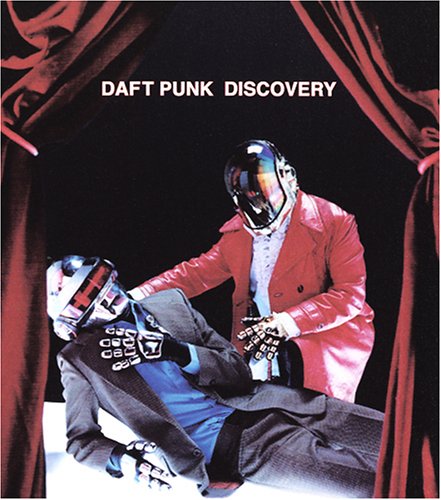

"Face to Face," a track with garage wunderkind Todd Edwards, twists his trademarked split-second samples and fully fragmented vision of garage into a dance-pop hit that could've easily stormed the charts in 1987. The only crime here is burying the highlight of the entire LP near the end. Due to slow internet speed at that time (in Europe), Alive 1997 was divided into 3 parts (called Daftendirektour Part 1/2/3). Every week or so a new track would be available. Daft Punk are such stellar, meticulous producers that they make any sound work, even superficially dated ones like spastic early-'80s electro/R&B ("Short Circuit") or faux-orchestral synthesizer baroque ("Veridis Quo"). Originally streamable on the Daft Club website (accessible with a Daft Club card given with the first press of the Discovery album). Abusing their pitch-bend and vocoder effects as though they were going out of style (about 15 years too late, come to think of it), the duo loops nearly everything they can get their sequencers on - divas, vocoders, synth-guitars, electric piano - and conjures a sound worthy of bygone electro-pop technicians from Giorgio Moroder to Todd Rundgren to Steve Miller. Though "Aerodynamic" and "Superheroes" have a bit of the driving acid minimalism associated with Homework, here Daft Punk is more taken with the glammier, poppier sound of Eurodisco and late R&B. "One More Time," the irresistible album opener and first single, takes Bangalter's "Music Sounds Better with You" as a blueprint, blending sampled horns with some retro bass thump and the gorgeous, extroverted vocals of Romanthony going round and round with apparently endless tweakings. Also in common with classic East Coast dance and '80s R&B, Discovery surprisingly focuses on songwriting and concise productions, though the pair's visions of bucolic pop on "Digital Love" and "Something About Us" are delivered by an androgynous, vocoderized frontman singing trite (though rather endearing) love lyrics. If Homework was Daft Punk's Chicago house record, this is definitely the New York garage edition, with co-productions and vocals from Romanthony and Todd Edwards, two of the brightest figures based in New Jersey's fertile garage scene. Deserting the shrieking acid house hysteria of their early work, the album moves in the same smooth filtered disco circles as the European dance smashes ("Music Sounds Better with You" and "Gym Tonic") that were co-produced by DP's Thomas Bangalter during the group's long interim. Discovery is by no means the same record, though. “As well as their parents.Four long years after their debut, Homework, Daft Punk returned with a second full-length, also packed with excellent productions and many of the obligatory nods to the duo's favorite stylistic speed bumps of the 1970s and '80s. “We hope all the kids will love the video,” a disembodied voice says near the end of the promo clip. And as implausible as it may have seemed for two French men in robot helmets, Discovery got them there. Most of all, though, Daft Punk wanted to be universal. Pepper’s Lonely Hearts Club Band or The Beach Boys circa Pet Sounds and Smile: music that took pop seriously as art, but also recontextualized older, seemingly uncool styles in ways that felt progressive and fresh.

But you can also trace it back to The Beatles circa Sgt. You can easily trace Discovery forward to EDM and the continuing entwinement of techno and rock. “Electronic music”-a term that always suggested the future, however vague-was demonstrated to be as familiar and comforting as classic rock, and no less real in its depth of feeling. And the rest-the faux-metal guitars of “Aerodynamic,” the sci-fi daydream of “Veridis Quo,” the UK garage showcase of Todd Edwards on “Face to Face”-glimpsed down dozens of stylistic alleyways without disrupting the album’s course. The album’s biggest singles-“One More Time,” “Harder Better Faster Stronger,” “Digital Love”-were as useful to wedding DJs as they were to pop philosophers. Dancing on the subway in a city where they didn’t speak the language, liberated from judgment and self-criticism: It’s all there in the title. And yet, when asked about Discovery’s turn toward ’70s and ’80s pop, Thomas Bangalter said the goal wasn’t to evoke a specific sound or era, but the raw wonder they’d felt encountering that music as children. At the time, Daft Punk was big enough business to dismiss goofing off-their first album, 1997’s Homework, had already sold two million copies. Some riders smile and stare, while others look politely away. There’s a video that Daft Punk made to promote 2001’s Discovery in which the French duo, wearing their famous robot helmets, dance on the Tokyo subway.


 0 kommentar(er)
0 kommentar(er)
